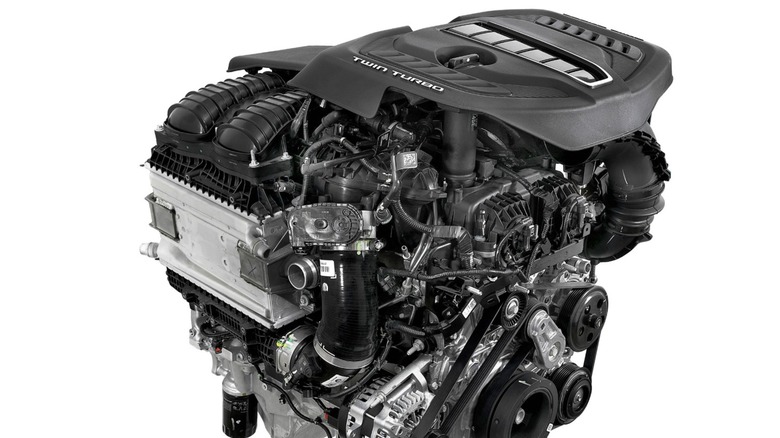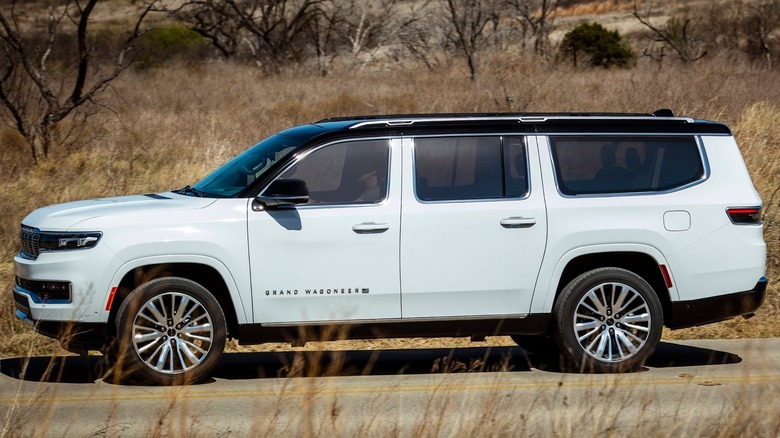3 Things To Know About Dodge's Hurricane Engine, Because Turbos Are Taking Over
Stellantis' Hemi V8 engine is dead. Well not technically, but if you go looking for a sedan or muscle car powered by a V8, you won't find it at Dodge or Chrysler. If it's not a heavy-duty Ram pickup or special edition SRT Hellcat Durango or Jeep Wrangler 392, you can't get a V8, and the engine isn't long for this world in those trucks and SUVs either. Smaller displacement, turbocharged engines have made a comeback in recent years, and Stellantis has finally gotten in on it for its largest and best-selling products.
The pseudo-discontinuation of the 5.7-liter Hemi V8 saw the introduction of a new engine to replace it. Dubbed Hurricane, the turbocharged 3.0-liter inline-6 is not only smaller but it's more powerful and more efficient. But what makes this engine so unique? Read on to learn three things about Stellantis' Hurricane inline-6 that make it special.
It's smaller and more powerful than the Hemi V8
Work on what would become the Hurricane began way back in 2013 as a direct response to Ford's EcoBoost engines, but it wasn't introduced until 2022. It's the first straight-six engine offered by an American automaker since GM's Atlas I6 that was used in its GMT360 platform SUVs in the early 2000s, and Chrysler hadn't offered one for years before that. The Hurricane engine is available in two power outputs: The standard version makes 420 horsepower and 486 lb-ft of torque, while a high-output version used in products like the Ram RHO and Jeep Grand Wagoneer makes as much as 550 horsepower and 521 lb-ft of torque. That makes every version of the Hurricane more powerful than both the 5.7-liter and 6.4-liter versions of the Hemi V8, and thanks to turbocharging, it makes that power with less displacement.
While both the standard and high-output versions of the Hurricane share over 90 parts and are largely identical, the engines do have their own unique turbos. The standard variant gets a turbo with 22 psi of peak boost while the high-output Hurricane gets 26 psi of peak boost from its turbo. The engines also run on different fuel, with the standard output Hurricane requiring regular while the high-output needs premium.
Modern tech, vintage name
The Hurricane name actually has historical significance for Jeep, having been used on an inline-4 engine that powered the Willys CJ-3, CJ-5 and CJ-6 for over 20 years. Despite that historical name, nothing about the modern Hurricane engine is old. Stellantis used some cutting-edge tech to develop and build the engines, especially given their small size and big power. Take the Hurricane's weight. Thanks in part to their lightweight cast aluminum block, both the standard and high-output versions of the engine weigh less than 500 pounds, with an 11-pound difference between the two (430 and 441 pounds respectively). Some surprisingly exotic solutions were also used for further weight savings. Plasma transfer wire arc technology is used to spray vaporized steel alloy onto the cylinder walls, something that has usually only been seen in high-performance engines like Ford's flat-plane-crank Voodoo V8 in the Mustang Shelby GT350 and the Nissan's VR38DETT twin-turbo V6 used in the GT-R.
The engine will make for an interesting muscle car
Dodge may have upset more than a few of its fans with the new Dodge Charger's lack of a V8 engine. Fans don't seem to be showing up to dealers for the electric version of Dodge's new muscle car. If you're one of those fans who want a muscle car with more power that isn't electric, all you have to do is wait until later this year as Dodge is set to release the gas-powered version of the Charger. Called the Charger Six Pack, buyers will be able to get both versions of the Hurricane in the new muscle car. With either 420 or 550 horsepower, it should make things pretty interesting for the Charger on the performance front.
Consider that both versions of the inline-6 outpower the old Charger SXT, GT, R/T and Scat Pack trims, which were available with either a 292-hp 3.5-liter V6, a 370-hp 5.7-liter V8 or a 486-hp 6.4-liter Hemi V8. Despite that power, we'll have to wait and see if buyers respond. Dodge fans were extremely loyal to the V8; the tire-shredding performance of the Scat Pack and Hellcat models were basically the Charger's entire identity. And it seems that without that V8 engine, many have washed their hands of the brand. Shrugging off the brand may prove to be premature, though, as Dodge has created something unique with the six-cylinder Charger. The five-door model looks like it'll be an American Kia Stinger thanks to its liftback rear end, and the Hurricane-powered models will still be rear-wheel drive, of course. If the performance of the Hurricane lives up to the engine's power figures, Stellantis and Dodge specifically may have a new hit on its hands.



